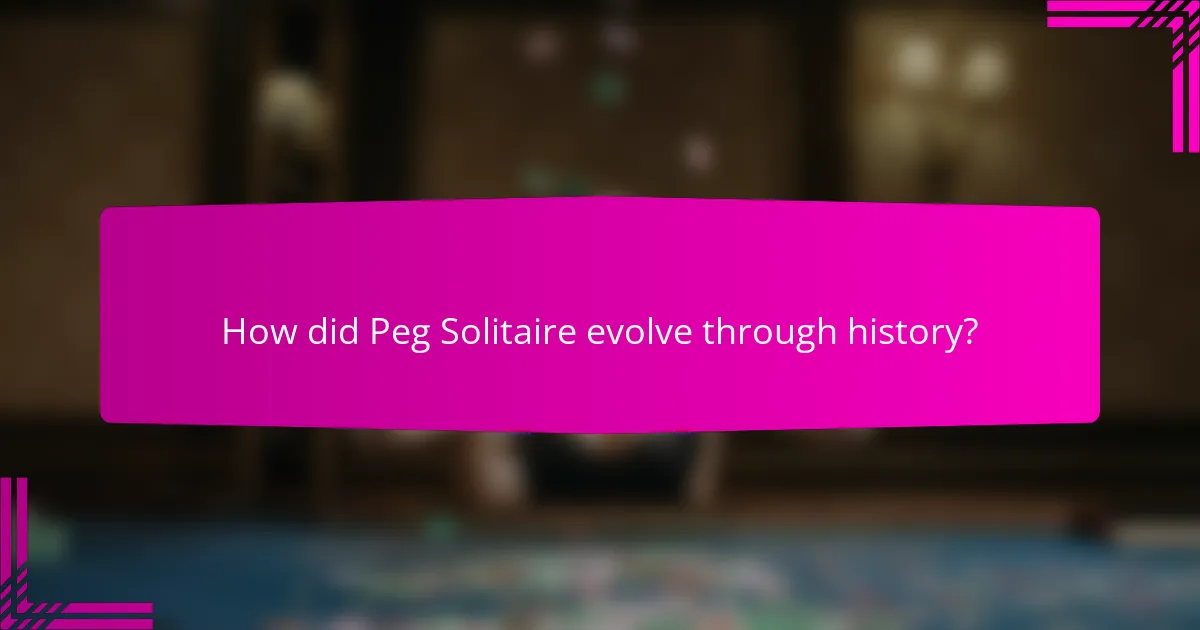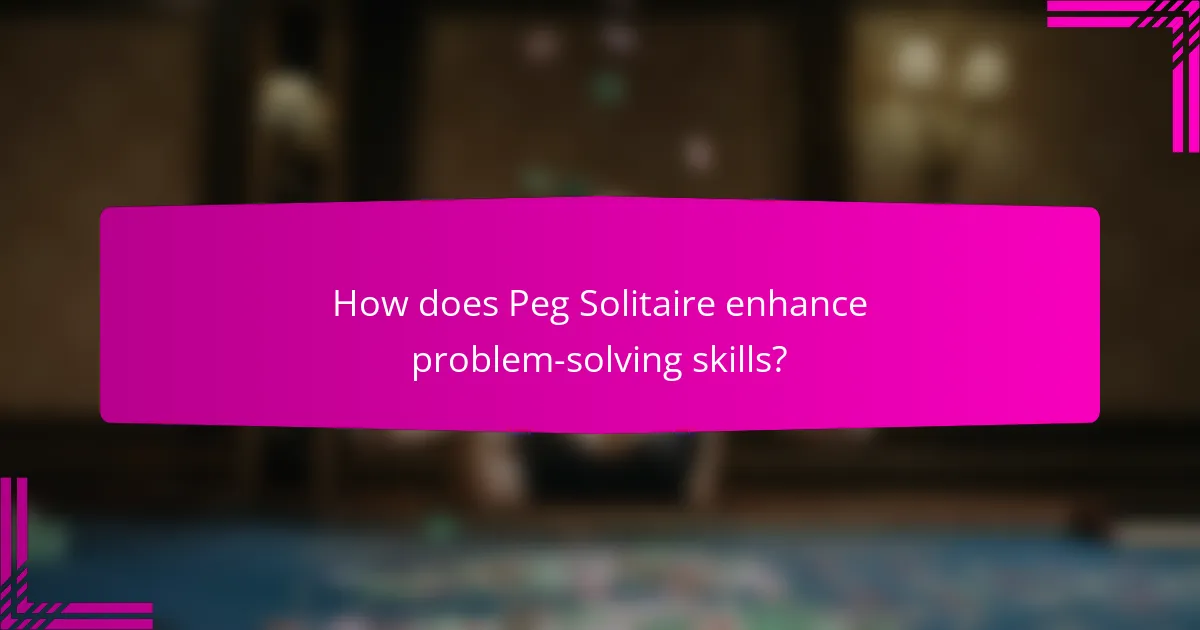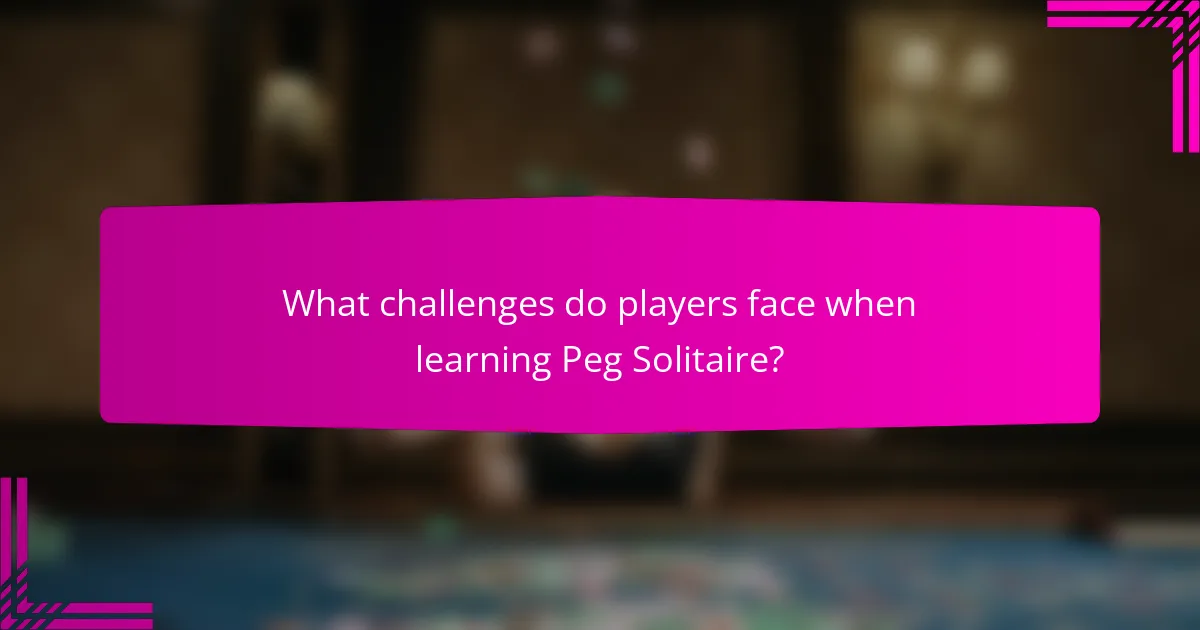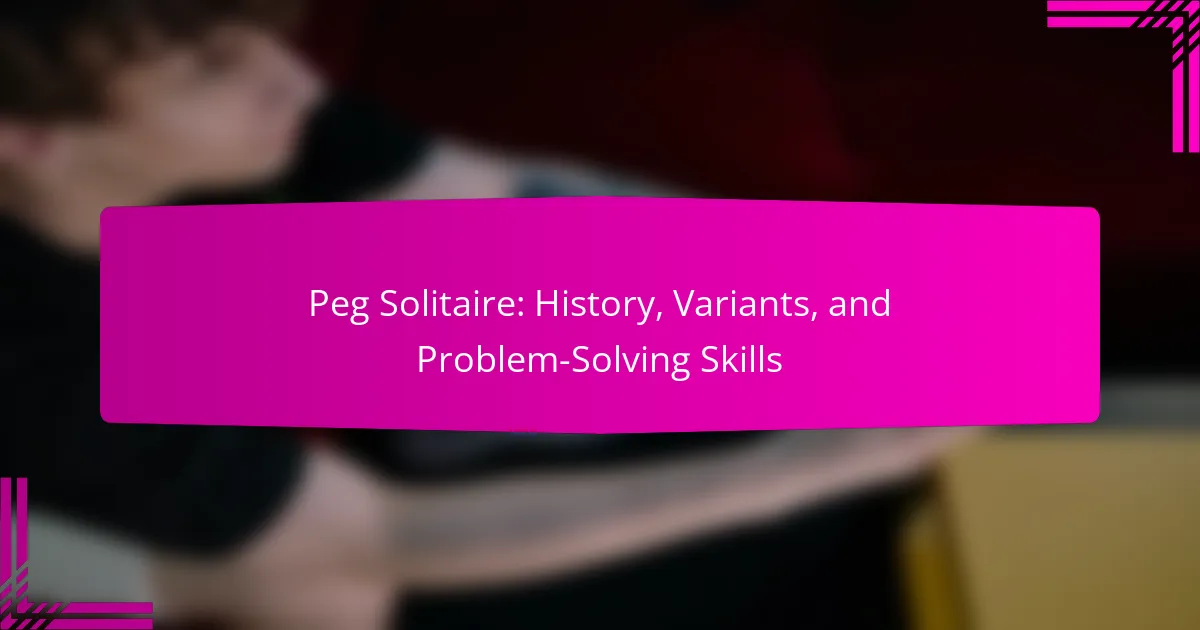Peg Solitaire is a strategic game that enhances problem-solving skills through its engaging challenges. This article explores its historical origins, popular variants, and the cognitive benefits it offers. Discover the unique rules of different board designs and learn effective strategies to master the game. Understanding these elements will improve your critical reasoning and decision-making abilities.

How did Peg Solitaire evolve through history?
Peg Solitaire evolved from ancient board games, with origins traced back to 17th century France. Initially known as “Solitaires,” it gained popularity in Europe, particularly in England, where variations emerged. The game transitioned from wooden boards to modern designs, influencing its strategic complexity. Over time, it became a tool for developing problem-solving skills, highlighting its educational value. Today, Peg Solitaire features numerous variants, including different board shapes and rules, reflecting its rich historical evolution.
What are the key milestones in the development of Peg Solitaire?
The key milestones in the development of Peg Solitaire include its origins in the 17th century, the introduction of various board designs, and the evolution of solving strategies. The game likely originated in France, evolving from earlier peg games. By the 19th century, it gained popularity across Europe, leading to diverse variants. Notably, the invention of algorithms in the 20th century enhanced problem-solving approaches, allowing for systematic solutions to specific configurations.
Which cultures have influenced the variations of Peg Solitaire?
European and Asian cultures significantly influenced the variations of Peg Solitaire. The game evolved through different regions, adapting its rules and board designs.
In Europe, the classic English version emerged, featuring a cross-shaped board. The French variant introduced a triangular board, showcasing unique strategies. The German variant, known as “Solitaire,” often includes additional pegs and complex layouts.
Asian cultures contributed their own interpretations, such as the Chinese version, which features a circular board and distinct gameplay. These cultural adaptations highlight the game’s versatility and the diverse problem-solving skills required across variations.
Why did Peg Solitaire gain popularity in different regions?
Peg Solitaire gained popularity in different regions due to its engaging problem-solving nature and cultural adaptations. The game’s simplicity allows for easy understanding, while its strategic depth appeals to various skill levels. In Europe, it became a staple in parlors, while in Asia, it often features unique board designs and rules. Additionally, its accessibility as a solitary game makes it appealing across diverse demographics.

What are the most popular variants of Peg Solitaire?
The most popular variants of Peg Solitaire include English, European, and French versions. Each variant features unique board designs and rules.
| Variant | Board Design | Unique Rules |
|————–|——————-|———————————–|
| English | Cross-shaped | Starts with one empty space |
| European | Star-shaped | Different starting configurations |
| French | Circular | Allows multiple jumps in one turn |
Which board designs are commonly used in Peg Solitaire?
Commonly used board designs in Peg Solitaire include the English cross, European cross, and triangular variations. Each design features a unique layout that impacts gameplay and strategy. The English cross board, for instance, has a distinctive shape with 33 holes, while the European cross typically has 37 holes. Triangular boards, such as the one used in the game “Marbles,” offer a different challenge with their 15 holes. These variations influence the complexity and problem-solving skills required for the game.
How do the rules differ among Peg Solitaire variants?
The rules of Peg Solitaire variants differ primarily in board shape, starting position, and movement restrictions. Classic English Peg Solitaire uses a cross-shaped board and allows diagonal moves, while European variants often feature different configurations and specific rules for piece removal. Other variants, like the triangular board version, introduce unique strategies and challenge levels, impacting problem-solving skills.
What are the notable adaptations of Peg Solitaire in modern gaming?
Notable adaptations of Peg Solitaire in modern gaming include digital versions, themed boards, and multiplayer formats. Digital adaptations often feature enhanced graphics and user interfaces, making the game more accessible. Themed boards introduce unique designs and challenges, appealing to diverse audiences. Multiplayer formats allow for competitive play, fostering social interaction and strategy development.

How does Peg Solitaire enhance problem-solving skills?
Peg Solitaire enhances problem-solving skills by requiring strategic thinking and foresight. Players must analyze potential moves and their consequences, developing critical reasoning. This game encourages pattern recognition as players identify winning strategies. Additionally, it fosters patience and persistence, essential traits for effective problem-solving. Overall, engaging with Peg Solitaire sharpens cognitive abilities and decision-making skills.
What cognitive benefits does playing Peg Solitaire provide?
Playing Peg Solitaire enhances cognitive skills such as problem-solving, critical thinking, and spatial reasoning. The game requires players to strategize moves, anticipate outcomes, and adapt to changing scenarios. These activities stimulate mental processes, improving overall cognitive flexibility. Engaging with the game’s variants further develops these skills by introducing new challenges and patterns, reinforcing the player’s ability to think creatively and analytically.
How can Peg Solitaire improve strategic thinking?
Peg Solitaire enhances strategic thinking by requiring players to plan moves and anticipate outcomes. This game fosters problem-solving skills through its various configurations and challenges. Players must analyze potential moves and their consequences, improving critical thinking and foresight. Additionally, mastering Peg Solitaire can lead to better decision-making in real-life scenarios by encouraging a methodical approach to challenges.
Which age groups benefit the most from playing Peg Solitaire?
Children and seniors benefit the most from playing Peg Solitaire.
For children, Peg Solitaire enhances cognitive skills such as problem-solving and critical thinking. Engaging with the game encourages strategic planning and improves focus. Seniors benefit by stimulating mental agility and memory retention, which can help slow cognitive decline. Overall, both age groups find enjoyment and mental engagement from this classic game.

What strategies can players use to excel at Peg Solitaire?
Players can excel at Peg Solitaire by mastering strategic moves and understanding board patterns. Focus on controlling the centre and creating isolated pegs. Develop a plan to eliminate pegs systematically, aiming for optimal sequences. Practice regularly to enhance problem-solving skills and recognize winning configurations.
Which common tactics lead to successful gameplay?
Effective tactics for successful gameplay in Peg Solitaire include strategic piece movement, anticipating future moves, and practicing pattern recognition. Players should focus on creating open spaces and minimizing isolated pieces. Mastering these tactics enhances problem-solving skills and overall gameplay efficiency.
What are the most frequent mistakes players make in Peg Solitaire?
Players frequently make mistakes in Peg Solitaire by failing to plan moves ahead, which leads to unresolvable board configurations. Common errors include jumping over pegs that do not contribute to clearing the board, not recognizing forced moves, and overlooking potential solutions. Additionally, players often focus on immediate gains rather than considering long-term strategies, which can hinder their progress. Understanding these mistakes can enhance problem-solving skills and improve overall gameplay.
How can players analyze their performance to improve?
Players can analyze their performance by reviewing their game outcomes and identifying patterns. Tracking moves and outcomes helps in recognizing strengths and weaknesses. Utilizing online platforms for feedback and engaging with community forums can provide additional insights. Regular practice and setting specific goals enhance problem-solving skills in Peg Solitaire.

What challenges do players face when learning Peg Solitaire?
Players face several challenges when learning Peg Solitaire, including understanding the rules, developing strategic thinking, and mastering different board configurations. The initial complexity of the game can be overwhelming, as players must learn to anticipate moves and outcomes. Additionally, players often struggle with spatial reasoning, which is crucial for visualizing potential moves. As a result, practice and patience are essential for improving problem-solving skills in Peg Solitaire.
Why do some players struggle with Peg Solitaire strategies?
Players struggle with Peg Solitaire strategies due to a lack of understanding of the game’s underlying principles. Many players do not recognize the importance of planning moves ahead and often focus on immediate gains. This short-sightedness can lead to dead ends, making it difficult to achieve the goal of clearing the board. Additionally, players may not be aware of various strategies, such as the importance of centralizing pieces or recognizing patterns that can lead to successful outcomes. Without these problem-solving skills, players may find themselves repeatedly facing challenges in completing the game.
How can beginners overcome initial challenges in Peg Solitaire?
Beginners can overcome initial challenges in Peg Solitaire by practicing strategic moves and understanding the game’s mechanics. Focusing on corner pegs and central positions helps create opportunities for jumps. Gradually increasing the complexity of the board and solving simpler patterns builds confidence. Utilizing online tutorials or guides can provide valuable insights into effective strategies and common mistakes to avoid.
What resources are available for improving Peg Solitaire skills?
To improve Peg Solitaire skills, players can utilize various resources such as books, online tutorials, and software applications. Books like “The Art of Peg Solitaire” offer strategies and historical context. Online platforms provide interactive solutions and forums for discussion. Software applications simulate the game, allowing for practice with different variants and difficulty levels.
What are the best practices for mastering Peg Solitaire?
To master Peg Solitaire, focus on strategic moves, practice regularly, and study solved puzzles. Understanding the board layout and potential patterns enhances problem-solving skills. Analyze each move’s impact on future options for optimal play.
